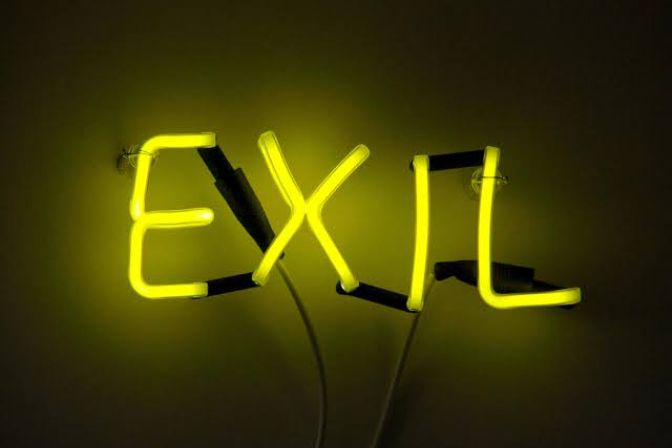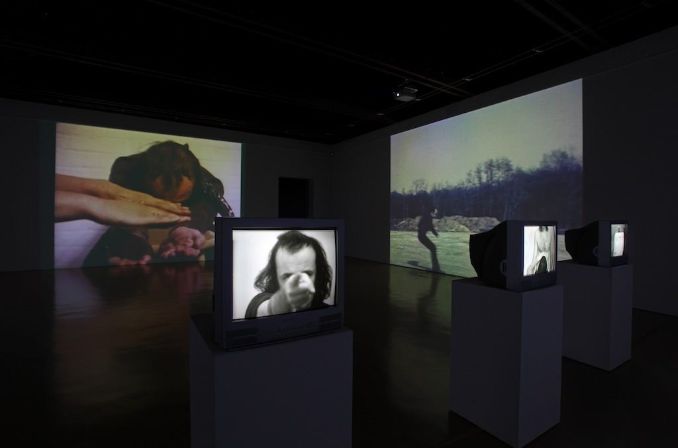Dancing in Peckham by Gillian Wearing CBE, RA (b. 1963, Birmingham) is video work that exemplifies the artist’s ongoing exploration of the boundary between public and private life, performance and authenticity, self and society. Shot in a shopping mall in southeast London, the video captures Wearing herself dancing—alone, without headphones, and to no audible music—amid the flow of daily shoppers. The artist’s movements are unselfconscious and eclectic, shifting from pop-inspired gestures to more abstract and unstructured motions. She appears entirely immersed in her own world, oblivious to the curious and occasionally bemused glances of passersby.
At first glance, Dancing in Peckham may seem whimsical or eccentric, even humorous. But beneath its surface lies a complex meditation on self-expression, social norms, and the politics of visibility. By placing herself in a public space, engaging in an act typically reserved for private or controlled environments, Wearing disrupts the routines and expectations of the shopping centre—an emblem of consumer culture and regulated behavior. The mall, usually a place of passive consumption and conformity, is transformed by her impromptu performance into a site of vulnerability, defiance, and unexpected intimacy.
The static framing of the camera and the absence of diegetic sound draw attention to the incongruity between Wearing’s internal experience and the external reality around her. Without the accompaniment of music, the viewer is left to imagine what she might be hearing or feeling, creating a dissonance that foregrounds the solitude of her act. The passersby, unwitting participants in the work, become part of the mise-en-scène, their reactions—curiosity, confusion, indifference—serving as silent commentary on the risks and rewards of standing out in a conformist environment.
Dancing in Peckham prefigures many of the themes that Wearing would continue to develop throughout her career. Her 1997 film 10–16, for example, takes this idea of performance and re-contextualizes it in a hauntingly different register. In this piece, adults lip-synch to the recorded voices of children aged between ten and sixteen, not only mimicking their words but also adopting their body language and physical mannerisms. The result is both poignant and unsettling. The adults become vessels for youthful anxieties, dreams, and confessions, performing identities that are not their own but rendered startlingly authentic through their embodiment.
In both works, Wearing explores a central paradox of identity: that adopting a role, putting on a mask, or stepping into someone else’s shoes can sometimes bring us closer to our true selves. This notion—that authenticity can emerge through artifice—runs through much of Wearing’s oeuvre. Her interest in reality television, fly-on-the-wall documentaries, and theatrical techniques reflects a fascination with how people construct and reveal their identities under observation. Whether interviewing strangers on the street, inviting participants to confess secrets behind masks, or performing in public spaces herself, Wearing consistently investigates how individuals navigate the gaze of others.
What makes Dancing in Peckham particularly resonant is its quiet subversiveness. It is not a grand
Dancing in Peckham by Gillian Wearing CBE, RA (b. 1963, Birmingham) is video work that exemplifies the artist’s ongoing exploration of the boundary between public and personal expression , performance and authenticity. Filmed in a busy South London shopping mall, it shows the artist dancing alone, without music or headphones, surrounded by passersby going about their daily routines. Her movements are uninhibited and varied, ranging from pop-like gestures to more abstract motions, suggesting an immersion in an inner world that feels radically out of sync with her surroundings.
What initially seems whimsical or eccentric soon reveals itself as a meditation on visibility, vulnerability, and the courage to deviate from social norms. The mall—a site of consumption and conformity—becomes the unlikely stage for personal expression. Wearing’s dance reclaims this space as one of emotional freedom and human presence. The reactions of onlookers—ranging from bemused to indifferent—highlight the risks of standing out and the unspoken rules that govern public behavior.
The work’s static framing and lack of diegetic sound create a stark contrast between Wearing’s inner experience and the external world. Viewers are invited to imagine the music in her mind, intensifying the sense of solitude and the subjective nature of the act. Like much of Wearing’s work, the piece examines how identity is performed and perceived under the gaze of others.
This concern continues in her later film 10–16 (1997), where adults lip-synch to the voices of children, embodying youthful anxieties and dreams with striking emotional resonance. Both works explore the paradox that performance—far from masking identity—can often reveal it more deeply.
Dancing in Peckham is powerful in its restraint. It is not a spectacle but an ordinary act made extraordinary by context. Through its simplicity, it asserts the right to be seen, to feel, and to take up space—even, and especially, in environments that discourage such presence. In doing so, it captures the poetic and political heart of Wearing’s practice.
Dancing in Peckham is part of UK/NY, a touring programme curated by Film and Video Umbrella and funded by Arts Council England.



